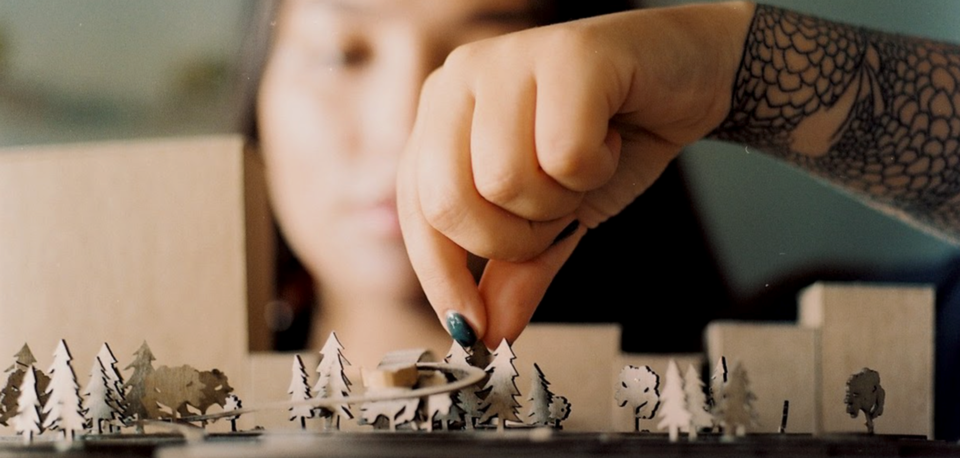What would our towns and cities look like if Indigenous peoples had been at the table all along?
For urban designer Sierra Tasi Baker, also known as K虛esugwilakw (pronounced Kay-soo-gwii-laow-kwoo), this question shapes their work.
A member of the S岣祑x瘫wú7mesh Úxwumixw (Squamish Nation) and principal of North Vancouver’s , Baker focuses on integrating Indigenous knowledge and values into urban planning and design.
“Squamish is part of our territory—it’s our family’s land,” Baker said, recalling their first visit to the district for a ceremony with their father.
“Ch’岣祑’elhp and Stá7mes are two of our ancestral villages. These places are so important to our history—they’re where our people rebuilt after the last Ice Age.”
Stá7mes is Stawamus Indian Reserve No. 24, where Totem Hall is located. Ch’岣祑’elhp or Chekwelp is located near Gibsons.
Baker’s perspective is rooted in their upbringing.
(Baker goes by they/them pronouns.)
Born into a family of artists, planners, and cultural knowledge keepers, they grew up hearing stories about their ancestors and learning about the land’s history.
Now, they are applying that knowledge to reimagine spaces like Stá7mes and Ch’岣祑’elhp as places where community, environment, and culture are central considerations.
Honouring ancestral villages
Recently, Baker’s firm partnered with the Nch’岣礱y虛 Development Corporation, the S岣祑x瘫wú7mesh Nation’s development branch, to create for Stá7mes and Ch’岣祑’elhp.
“These aren’t just places—they’re our origin villages,” Baker said.
“We’ve developed a unique approach that’s rooted in our teachings. Instead of dividing land into industrial, residential, and commercial zones like Western planning does, we focus on relationships—cultural, environmental, and community-based.”
The result is a vision for land use that prioritizes sustainability, cultural preservation, and environmental stewardship.
“Imagine if cities were designed to honour the land instead of exploiting it,” Baker said.
“Our ancestors innovated for thousands of years, building resilient communities in hydrologically active territories. We used cedar, diatomaceous clay, and other natural materials that work with the land, not against it. These methods are more sustainable than concrete, but urban design hasn’t caught up yet.”
Cedar has been for thousands of years because it naturally resists rot and insects. from the World Resources Institute shows it’s also an eco-friendlier alternative to concrete.
The work in Squamish, Baker noted, isn’t just about preserving the past—it’s about creating a future that reflects the deep connection Indigenous people have to their land.
“When we talk about design, we’re really talking about sovereignty,” they said. “We’re talking about taking back control over how our lands and waters are used and cared for.”
Making space for Indigenous voices
Baker’s projects extend beyond Squamish to Vancouver and beyond.
They’ve contributed to the redesigning of Vancouver’s Imagine West End Waterfront, worked on the Britannia Renewal plan, and helped develop the RayCam Co-operative Centre.
But they’re also quick to point out the challenges of working in a field that remains predominantly white.
“Every day, I face racism in this field,” Baker said.
“Many people don’t realize they’re settlers on Indigenous land. There’s a lack of understanding about what that means and how it perpetuates harm. Developers don’t see the ongoing impacts of colonialism, but they’re participating in it.”
In 2016, , including First Nations, Métis, and Inuit, lived in urban areas. However, according to , Indigenous voices have historically been marginalized in the design and organization of Canadian spaces, even within their own communities.
“This industry hasn’t been safe for BIPOC people,” Baker said.
“Historically, design has been used to displace and harm our communities. That’s why it’s so important to change who is leading these projects and whose voices are being heard.”
Organizations like the are actively working to increase Black and Indigenous representation in spatial design disciplines, aiming for significant progress by 2050.
Through BIDC, Baker helps empower emerging professionals to enter fields like architecture, urban planning, and public art.
“We’re building capacity, providing mentorship, and creating opportunities for the next generation of Black and Indigenous designers,” Baker said.
Imagining an Indigenous future
If Baker could design their dream project, it would look like something out of a sci-fi movie—but deeply grounded in the past.
“I want to create an Indigenous futurism city,” Baker said.
“It would be built entirely on our ancestral knowledge and teachings, designed by Black and Indigenous professionals from around the world.” they said.
“If Le Corbusier could design a colonial city, why can’t we create a decolonial one?” Baker said referencing the famed modernist architect who is often criticized by many for designs often prioritized efficiency over community and reinforced colonial hierarchies.
For Baker, the work isn’t just about buildings or infrastructure—it’s about relationships. “Every project we take on begins with the story of the place,” Baker said.
“When we reconnect with those stories, we can build spaces that truly reflect who we are.”
What’s next for Squamish?
Although Baker’s work in Squamish has included partnerships with Nch’岣礱y虛 Development Corporation and Hiy虛ám虛 Housing, they believe that there’s still a lot of untapped potential in the city.
“We’ve done consulting projects within Squamish municipality, but no large-scale urban design work in the city itself yet,” Baker said.
“There’s a huge opportunity here to rethink how we design spaces—to make them truly inclusive and reflective of Indigenous values.”
Future of urban design
For Baker, the future of urban design is about more than aesthetics—it’s about justice.
“Design is a powerful tool,” Baker said.
“It can be used to displace people, or it can be used to uplift communities and restore relationships with the land.”
“What would our world look like if we listened to the people who have been here for thousands of years?” Baker asked. It’s not too late to find out.
Bhagyashree Chatterjee is The 小蓝视频’s Indigenous affairs reporter. This reporting beat is made possible by the .




